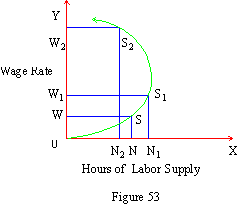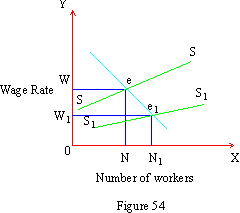|
14.3 Supply Curve of Labor
(A) Backward Sloping Supply: The labor supply
curve of a single worker may not be smooth and straight. It is likely
to be backward bending or sloping in nature. On such a labor supply
curve, a worker will initially increase the supply of a number of
hours of work with a rise in the rate of wages. Once his estimated
need of wage income is satisfied he is likely to prefer leisure
or rest from work. Leisure is an attractive
alternative to work and hence it is the opportunity cost at further
hikes in the wage rate. This has been shown in Figure 53.

In the figure the number of hours of labor supplied
have been measured along OX axis and the rate of wages along OY
axis. When the initial wage rate is as low as W a worker supplies
N hours of labor. With a rise in the rate of wages to W1
he has an incentive to work longer and to earn a higher income.
Therefore the worker offers more hours of labor (N1).
The labor supply curve SS1
slopes upwards as is normally expected. Beyond W1
if the wage rises further as W2
the worker may withdraw some hours of labor. He may prefer more
leisure than work. Therefore supply of labor drops to fewer hours
as N2.
The supply curve S1S2
bends backward.
This is the typical nature of the labor supply
curve. This can be explained both with the help of income and substitution
effects. Beyond point S1
and wage rate W1 the
worker feels that an adequate income has already been earned by
him. Therefore beyond this point he prefers leisure to income. This
is termed the negative income effect. Also, more work and
more income, on the one hand, and more leisure, on the other, are
substitutes of each other. About 10 or 12 hours of work leisure
may be given up in preference to income but, beyond that, leisure
is considered more valuable. Therefore it is substituted in place
of work and income.
(B) Market Demand and Supply Curves for Labor:
Under a perfect competitive market both demand and supply curves
are likely to be normal in behavior. Demand curve for labor will
then be downward sloping. In a market numerous firms operate; so
the demand curve will be more flexible than in the case of individual
firms. Labor supply curve will be composed of the additions of labor
supplied by individuals. This is likely to slope upwards. It indicates
that both labor of a higher quality and skills are supplied only
at a rising rate of wages. Under competition, with a very large
number of workers and with less significant personal differences,
the supply curve will be highly flexible tending to be a horizontal
straight line. Given the demand and supply schedules or curves competitive
market equilibrium can be determined.

In Figure 54, DD and SS represent the competitive
labor demand curve and the competitive supply curve respectively.
The two curves intersect at point e which is a point of equilibrium.
Under equilibrium condition, N number of workers offer supply of
labor and receive the wage rate W. If labor market shows a greater
homogeneity and if the qualitative variations are very few then
the supply curve will be more flexible as represented by S1S1.
With such a supply curve under the given demand conditions, a new
point of equilibrium e1
is established. At this point more workers N1
offer services at a lower wage rate W1.
Thus demand and supply conditions together determine level
of employment and rate of wages in a competitive market.
[next page]
|